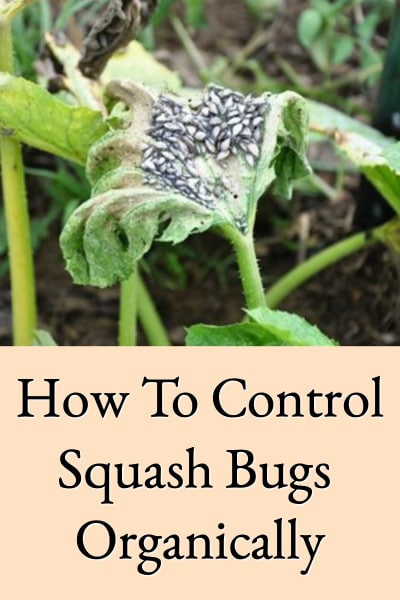
At first glance (in the photo below), this zucchini plant looks like it’s doing great – right? It looks so nice and lush, I’m sure there must be a bumper crop of zucchini on the way. And since it’s been a year since we’ve been harvesting zucchini, we’re ready for them!
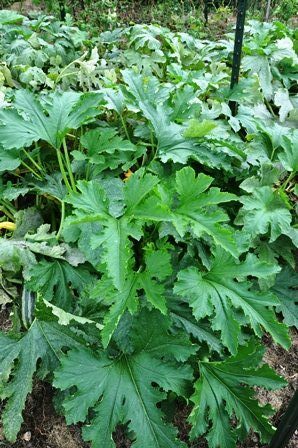
Lush Looking Zucchini Plants
I like to use them in lots of casseroles that we eat all fall, winter, and spring – until it’s zucchini time yet again.
But if you look a little closer, things are not quite as great as it first appears – there are squash bugs in there!
What Are Squash Bugs?
They’re brownish-black bugs (officially Anasa Tritis species) that are about 3/4″ – 1″ long. They feed on the leaves of vining crops like squash, pumpkins, and melons. You can read more about them on Wikipedia HERE.
As you can see in the photos below, their feeding causes the plant to wilt and will eventually cause it to die. They’re generally found wherever these vining crops are grown. Ugly, aren’t they?
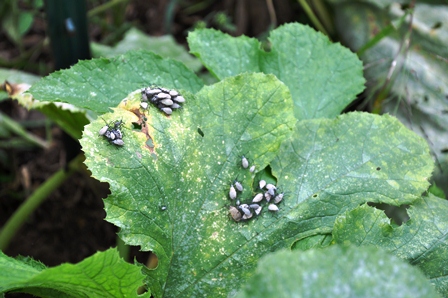
Zucchini Leaf Infested With Adult Squash Bugs
Controlling Squash Bugs Organically
Organic controls for squash bugs include:
- Planting flower and vegetable varieties that repel them (obviously I didn’t do enough of that). These include things such as marigold, nasturtium, and radish.
- Practicing good garden sanitation and weed control are important as these bugs tend to hide beneath the foliage. If you can’t see what’s going on in the garden because of too many weeds or overcrowding, it’s often hard to find these bugs.
- Inspect your garden daily and once you find them, handpick and destroy all the insects and eggs (or simply destroy the entire stalk). The eggs are dark red and are laid in clusters on the leaves.
Squash Bug Eggs, Anasa tristis species.
- Practice crop rotation (see Crop Rotation – A Simple System) to help keep these guys under control. It’s much harder for them to infest a plant if they can’t find it because it’s in a new location this year.
- If you have a good supply of wood ashes available, dusting the stems and leaves with wood ash can help prevent squash bug infestations.
The good news is that they do tend to cluster, so if you’re inspecting your garden regularly you can usually catch and handpick these before they do cause an otherwise healthy plant to die.
After carefully removing and destroying the infested zucchini stalk below, the plant made a nice recovery and supplied lots of squash!
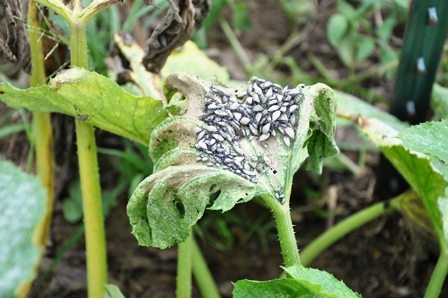
Squash Bug Infested Zucchini Stalk
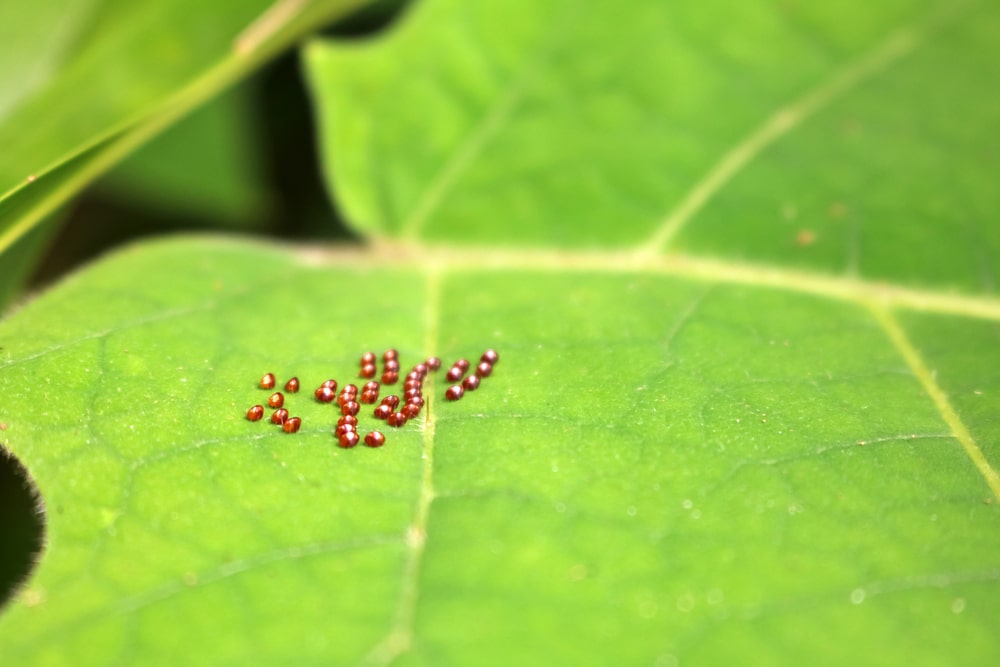
Krystyna says
Do you have any suggestions for Squash Vine Borers? I know that they’re after the squashes for similar reasons. They ran rampant over our gardens on both sides of our house, not only going after summer squash, but killing our winter squash plants, too. We tried BT with no success.
Lesa says
Hi Krystyna, yes those squash vine borers can really do a lot of damage! There are a couple of things you can try. 1) If you catch it soon enough, you can remove the borer by slitting the stem at the injured entry point and then cover the damaged stem under a little soil and roots and new growth should start. 2) Covering the hill with a box (wooden or fiberboard) about 18″ square by 12″ deep (open at the top and bottom) and stretching some cheesecloth over the top will protect the young plants when they’re young and most vulnerable. 3) Dusting with wood ashes can also be effective, just be sure to dust the base and stems well and frequently. Hope these ideas help!
Ariel says
Two things that have helped me with squash bugs are as follows: First, if you have hot pepper seeds left over from Jalapeño pepper projects, like jelly, spread them around the area of your plants. Any hot pepper seed helps. The next one is more time consuming, but it works on most insects and does not harm the valuable ones. Take a quart of water, add a whole clove of garlic, chopped course. Add a small chopped onion and a tea spoon of cayenne pepper. Mix and let it sit at least an hour. Add a tea spoon off dish soap. mix, run it through a cheese cloth, or fine filter of choice. Put it in a spray bottle shake gently, and get busy. It also discourages deer for awhile thay hate the smell. Bath before leaving home to avoid being shunned. Also, tin foil around the base of any squash plant helps, but you have to do it early and secure, going just under the surface of the soil and up an inch. I live in Ga. We grow squash bugs here as our main crop.
S.Lynn says
We’ve fought them for past four years. We planted one zucchini early in the season which attracted the bugs. We used soapy water to kill them. Then a month later started a couple more zucchini’s and tossed the original one in the burn pile. It seemed to help mitigate the bugs on the new plants.
Erin says
These bugs were the bane of my existence last growing season! Thanks for the tips!
Mike the Gardener says
the past two years the squash bugs have been light (knock on wood) … we have had pretty cold winters and I believe that has had a lot to do with it. Just my guess. In other seasons what I have done is take a proactive stance on them and constantly look on the underside of the leaves for their eggs. I would then take a propane torch (available at any home center for a few bucks) and burn the eggs. Full proof? no. Extreme? maybe. But it did keep the population low.
Jean says
Wouldn’t the propane torch kill the plant also? I’ve been fighting them the past 2 years and even though I pick off all of the eggs daily, they still win.